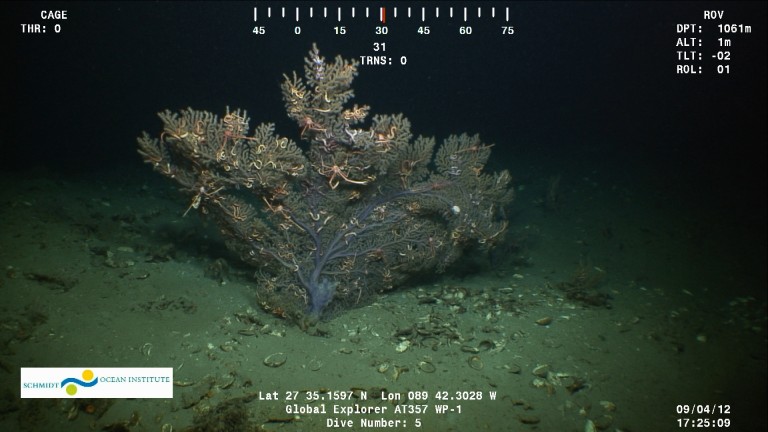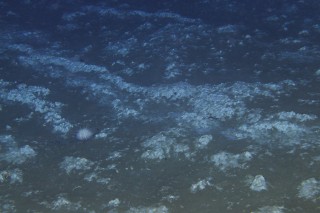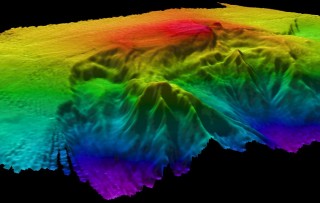
Today, we had our fourth and final dive at a site called AT357, which had been visited previously by some members of our research team in 2009 and 2011. “AT” stands for Atwater Valley, a sub region of the northern Gulf of Mexico.
The remotely operated vehicle (ROV) touched down on soft sediments at 1050 meters of depth, moved over a hydrocarbon seep, and then encountered many large gorgonian sea-fans called Paramuricea that were so densely covered with invertebrate associates that they almost looked like Christmas trees.

The team landed near grey colored bacterial mats on the sediment, as well as Calyptophora clams and dead Bathymodiolus mussels. These organisms are evidence of hydrocarbons seeping from the seafloor. PhD student Mauricio Silva has been working with cold seeps in Chile, and more recently in the Gulf of Mexico. He says, “Cold seeps feature complex chemosynthetic communities that don’t rely on surface production [energy derived from the sun] but create their own food from chemicals like methane and sulfur.”
Cold seeps are geologically interesting. “In the Pacific, we find seeps that are caused by plate tectonics, so the movement of sediment creates faults which enable hydrocarbons to come up to the surface. This differs to those found in the Gulf of Mexico, which are caused by salt. Millions of years ago, salt accumulated on the bottom of the seafloor as a result of evaporation, and when the sea level rose again, sediment covered this salt layer. Salt is more buoyant than the sediment, so it rises up to form banks and mounds that penetrate the surface. This provides a route for hydrocarbons to seep out of the seafloor.”
He adds, “Seeps usually occur in soft sediment, but chemical processes ultimately result in the production of authigenic carbonates which provide hard structure for corals to settle on.”

As the team approached the peak of the mound feature, they encountered large purple Paramuricea with a variety of brittle stars, chirostylid crabs, and shrimps. The brittle stars were of particular interest, as there appears to be more than one species on the same coral and these seem to be different species compared to those we have found at other sites.
This article’s author has had a dual role on this research cruise, as an outreach coordinator as well as a biologist. Part of my work in Dr. Timothy Shank’s lab has been analysing images of invertebrate associates collected in October last year at sites in this region, including AT357. In the span of a few days we have visited my two favorite sites in the Gulf of Mexico, DeSoto Canyon and AT357. I like them for different reasons: DeSoto Canyon has high octocoral diversity. AT357 is predominately Paramuricea, but the diversity of animals associated with these colonies is high.
The dive lasted about 2 hours before it was shortened by a power failure. The lights went out in the control room and the ROV winch was immediately activated to lift the vehicle off the seafloor for safety. Power returned within 5 minutes and the ROV returned briefly to the seafloor for more imagery before the power went out again. The team recovered the ROV safely and intact, with all the collected data.
Chief Scientist Peter Etnoyer has worked tirelessly to make the ROV dives successful and productive. He said, “In the end, we finished with four good dives between 500-2000 meters depth. Each dive brought new information that helps plan for future management and exploration, so I am pleased with Falkor’s performance.”

